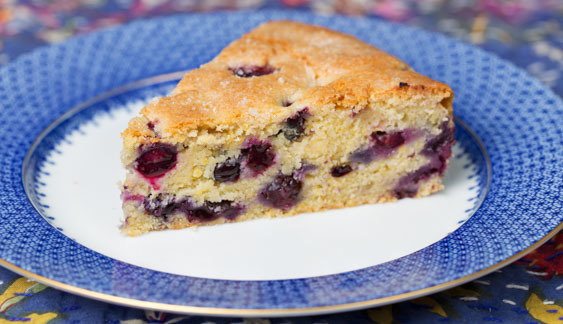Blueberry Polenta Cake

introduction
We had been playing around the edges of a polenta cake for years. We had a finished recipe and a gorgeous photo, but the cake’s texture was not reliably on point. Polenta is a trickier ingredient than cornmeal in baking because the flint corn used for polenta mills to a more granular finish than does the dent corn used to mill cornmeal. Fine, and even coarse, cornmeal will spring into a cake batter like any dry ingredient; polenta will not. And though we made initially made polenta mush to fold into the batter, the results remained imperfect.
Three years on, having verily forgotten the frustration of our first exercise, we decided to have another go at a big, fat polenta cake—this time, to compound the challenge, a big, fat polenta cake with blueberries. The average cake batter cannot hold blueberries in suspension once subjected to oven heat, so the berries sink to the bottom, where they form a soggy blueberry diaper. Our task, then, was to persuade the polenta to shoulder its responsibility as a dry ingredient and to formulate a batter thick enough to prevent blueberry sinkage, but one still capable of yielding a nice, moist, open crumb. Enter ricotta. While not strictly a liquid, the polenta “blooms” in the cheese overnight, the cheese’s moisture brings the batter together, and the curds yield a crumb that is wonderfully tender and delicate but pleasingly coarse and decidedly casual. Miraculous. This is an absolutely delicious cake, sunny with the flavor of corn and blueberry, moist, and eaten right out of hand.
Baking Notes
This is a cake for the summer, when blueberries are fresh, sweet, and in season. Don’t even think of attempting the recipe with frozen berries, which will stain the batter an unappetizing grey-blue hue. These days, fresh blueberries at the grocery store are sometimes monstrous—we’ve seen ones even larger in diameter than a penny! If you have any control over the matter, choose small- to medium-sized berries, as they attain nicer distribution in the cake.
Use the best ricotta you can find. If your city has an Italian neighborhood, go there! Be sure to choose cheese made with whole milk, not skim milk. Upon standing, ricotta separates a bit and moisture within rises to the surface.This is whey—don’t discard the liquid—rather, stir it into the cheese before weighing. The polenta, when mixed into the ricotta, absorbs all and any moisture and its granules swell and soften. Made with unsoaked polenta, the cake’s crumb has a marked grittiness—not strictly ruinous, but not the texture we’re so pleased with. Plan ahead and combine the polenta and ricotta the night before.
Though rustic and coarse, the crumb of this cake is also quite fragile, so it’s best to let it cool completely before cutting and serving.
equipment mise en place
For this recipe, you will need a digital kitchen scale, a medium and a small bowl, a 9-inch round cake pan with 2-inch sides, parchment paper, a stand mixer fitter with the flat-beater attachment, a rubber spatula, a small offset spatula or a spoon, a paring knife, a wire rack, and a large plate.
-
-
8ounces (1 cup) whole-milk ricotta cheese
-
3ounces (½ cup) Anson Mills Artisan Handmade Fine Yellow Polenta
-
8.5ounces (1⅔ cups plus 1 tablespoon) Anson Mills Colonial Style Fine Cloth-Bolted Pastry Flour, plus additional for dusting the cake pan
-
2teaspoons baking powder
-
⅝teaspoon fine sea salt
-
5.5ounces (11 tablespoons) unsalted European-style butter, room temperature, plus additional butter for greasing the cake pan
-
6.5ounces (¾ cup plus 1 tablespoon) sugar, plus 1 tablespoon for sprinkling
-
2teaspoons finely grated lemon zest
-
2large eggs, room temperature
-
2teaspoons vanilla extract
-
12ounces (scant 3 cups) fresh blueberries
-
-
In a medium bowl, stir together the ricotta and polenta until well combined. Cover with plastic wrap and refrigerate overnight.
-
When you’re ready to bake, remove the ricotta-polenta mixture from the refrigerator and bring it to room temperature. Adjust an oven rack to the lower-middle position and heat the oven to 350 degrees. Butter a 9-inch round cake pan with 2-inch sides, line the bottom with a parchment-paper round, and butter the paper. Dust the pan with flour and knock out the excess.
-
In a small bowl, whisk together the pastry flour, baking powder, and salt. In a stand mixer fitted with the flat-beater attachment, cream the butter, sugar, and lemon zest on medium-high speed until light and fluffy, about 3 minutes, scraping down the bowl with a rubber spatula as needed. One at a time, add the eggs, beating on medium-high speed until well combined and scraping down the bowl after each addition. Add the vanilla and the ricotta mixture, beat on medium speed until combined, and then scrape down the bowl. With the mixer running on low, add the flour and mix until just incorporated. Detach the mixer bowl and fold the batter with a rubber spatula to ensure no pockets of flour remain; the batter will be extremely thick. Fold in the blueberries until evenly distributed and scrape the batter into the prepared pan. Using a small offset spatula or the back of a spoon, spread the batter into an even layer and level the surface. Sprinkle evenly with the 1 tablespoon sugar.
-
Bake until the cake is well risen, deep golden brown, and a toothpick inserted into the center comes out clean, about 50 minutes. Let cool in the pan on a wire rack for 15 minutes, and then run a paring knife around the inside edge to loosen the cake from the pan. Invert the cake onto a large plate, re-invert into onto the wire rack, and let cool to room temperature. Cut into wedges and serve.